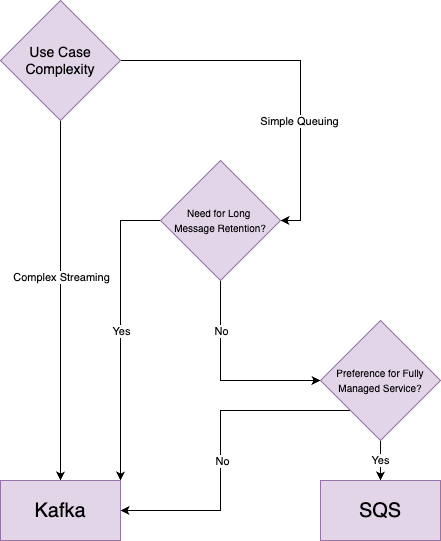Kafka vs SQS
Introduction
Apache Kafka and Amazon Simple Queue Service (SQS) are two widely used technologies for managing messages and data streams in distributed systems. Both messaging services enable asynchronous communication, but they offer distinct approaches and capabilities. Understanding the differences is essential to ensure alignment with specific system requirements and architectural needs.
Overview of Apache Kafka
Apache Kafka is an open-source stream-processing platform that can handle high volumes of data and allows for the building of real-time data pipelines and streaming applications. Its high throughput, durability, and design for distributed environments make it suitable for systems processing large amounts of real-time data. With its distributed architecture, Kafka is ideal for building scalable, fault-tolerant data streaming applications.
Key Features of Kafka:
- High Throughput: Designed to handle high volumes of data efficiently.
- Distributed Nature: Kafka runs as a cluster of brokers for fault tolerance and scalability.
- Durability and Reliability: Stores data on disks and replicates within the cluster to prevent data loss.
- Flexible Consumer Groups: Supports complex processing pipelines and multiple consumers per topic.
Use Cases for Kafka:
- Event-Driven Systems: Ideal for implementing event sourcing architectures.
- Real-Time Data Processing: Effective for analytics and monitoring applications.
- Log Aggregation: Collects and processes logs from different services.
Favorable and Unfavorable Scenarios:
This system thrives in large-scale distributed environments with high-throughput needs but proves overly complex for small-scale or basic queuing applications.
- Favorable: Large-scale distributed environments with high-throughput requirements.
- Unfavorable: Overly complex for small-scale or simple queuing applications.
Overview of Amazon SQS
Amazon SQS is a fully managed message queuing service offered by AWS. It's designed to decouple and scale microservices, distributed systems, and serverless applications. It ensures efficient communication among distributed software components by removing the need for queue infrastructure management, facilitating the sending, storing, and receiving of messages.
Key Features of SQS:
- Fully Managed Service: Requires no administration or maintenance of messaging infrastructure.
- Scalability: Automatically scales to handle demand.
- Two Types of Queues: Standard queues for maximum throughput and FIFO queues for ordering guarantee.
- Integration with AWS: Seamlessly integrates with other AWS services.
Use Cases for SQS:
- Decoupling Microservices: Helps in separating components in a system to increase reliability.
- Serverless Applications: Works well with AWS Lambda for serverless architectures.
- Simple Task Queues: Efficient in managing asynchronous tasks.
Favorable and Unfavorable Scenarios:
SQS works best in scenarios needing straightforward queuing with minimal setup, but falls short in handling complex streaming tasks or when extensive system control is necessary.
For example, it’s a good choice for sending order confirmation emails in an e-commerce application, but not ideal for real-time data processing in a financial trading system.
- Favorable: Best suited for applications requiring simple queuing with minimal setup.
- Unfavorable: Not ideal for complex streaming or when extensive control over the system is needed.
Comparison
Apache Kafka and Amazon SQS are designed for asynchronous communication, fault tolerance, and scalability, efficiently handling large volumes of messages without losing data. However, they differ in setup complexity, with Kafka requiring manual configuration compared to SQS's fully managed approach.
Kafka offers high throughput, long message retention, and diverse data format support, but requires manual configuration. SQS, on the other hand, provides a fully managed, pay-as-you-go queuing solution within AWS, suitable for simpler applications. Kafka's scalability relies on brokers and partitions, while SQS automatically adjusts to message volume.
Similarities:
- Asynchronous Communication: Both facilitate asynchronous data processing.
- Scalability: Designed to handle a large number of messages.
Differences:
- Management and Operation: Kafka requires manual setup and management; SQS is a fully managed service.
- Use Cases: Kafka is more suited for complex, real-time streaming and event-driven applications, whereas SQS is tailored for simple queuing needs.
- Performance: Kafka offers higher throughput and more flexibility in message processing compared to SQS.
- Message Retention: Kafka supports longer, configurable retention; SQS limits to 14 days.
- Data Format: Kafka accepts any data format, including JSON, Avro, and Protobuf. SQS mainly handles simple text formats.
- Pricing Model: Kafka pricing varies with deployment; SQS uses a pay-as-you-go model.
- Integration and Ecosystem: Kafka has a rich set of integration tools; SQS integrates well within AWS.
- Consumer Management: Kafka consumers manage their own offset; SQS uses a push model based on visibility timeout.
- Scaling: Kafka scales with brokers and partitions; SQS auto-scales with message volume.
Decision Flow Chart
Here is a simple flow chart based on the pros and cons of each service:

Conclusion
The choice between Kafka and SQS depends on specific project needs. Kafka is ideal for high-volume, real-time streaming and complex event processing systems. In contrast, SQS is more suitable for simple queuing purposes, particularly for applications within the AWS ecosystem and those requiring a managed service. Understanding each technology's strengths and limitations is key in selecting the appropriate tool for your messaging and queuing needs.